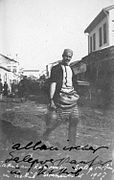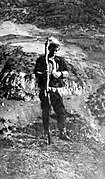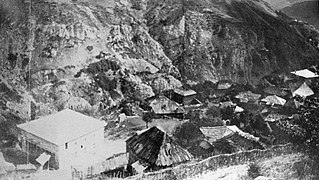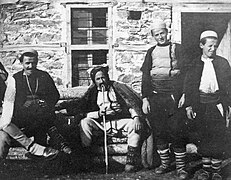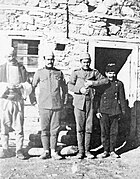バヤジッド・ドゥーダ
バヤジッド・エルマズ・ドゥーダ | |
|---|---|
 | |
| 生誕 |
1888年 オスマン帝国、Štirovica |
| 死没 |
1933年(44 - 45歳没)4月25日 オーストリア、ウィーン |
| 死因 | 銃創 (殺人) |
| 職業 | 写真家, 民族誌家, 作家 |
| 非婚配偶者 | フランツ・ノプシャ |
バヤジッド・エルマズ・ドゥーダ(Bajazid Elmaz Doda、1888年-1933年4月25日)は、アルバニアの民族誌作家、写真家である。[1] 1914年にウィーンで執筆された『Albanisches Bauerleben im oberen Rekatal bei Dibra (Makedonien) (Albanian Peasant Life in the Upper Reka Valley near Dibra (Macedonia)) 』の著者であり、オスマン帝国に属していた時代のアルバニア人の居住地、特に彼の生まれ故郷である上レカの20世紀初頭の貴重な写真を数多く残している。 カメの化石種Kallokibotionは、彼の恋人フランツ・ノプシャによって彼にちなんで命名された。
生涯
[編集]バヤジッド・ドゥーダは、1888年に当時オスマン帝国領だったマケドニアの上レカ地方にあるアルバニア人が住む村Štirovicaで生まれた。[2] 彼は、他の上レカ地方住民の多くと同様に、海外で働くためにルーマニアに行った。[3]1906年にルーマニアのブカレストで、ハンガリーの男爵で学者のフランツ・ノプシャ (1877-1933) に会い、彼は彼を使用人として雇った。[3] 二人は恋人同士となり、一緒に暮らし始めた。[3]
ノプシャとドゥーダはブカレストを離れ、トランシルヴァニアのサセルにあるノプサ家の邸宅に向かい、その後ロンドンで数カ月間過ごしたが、そこでドゥーダ はインフルエンザに罹った。[3] 1907年11月中旬、二人はShkodërに旅行し、そこで1907年から1910年まで、そして1913年10月から再び家を維持した。[3] 彼らはMirditëを旅し、有名な山賊Mustafa Litaに誘拐された。[3] プリズレンで釈放された後、彼らはスコピエに旅行し、上レカにあるドゥーダ の家を訪問した。[3] Shkodërに戻った彼らは、ホティ族とグルーダ族の土地を訪れた。[3] 二人は一緒に、あるいは別々にアルバニア全土を旅した。[3] 1915年から1916年の第一次世界大戦中、ノプシャはコソボでオーストリア=ハンガリー軍に従軍中にドゥーダを連れて行った。[3] 戦後、彼らは主にウィーンに住み、そこでノプシャは数冊の本を出版し、アルバノ学者としてだけでなく、古生物学者および地質学者としても知られるようになった。[3] しかし、彼らは約3年間、バイクでヨーロッパ中を旅して化石を探した。[4][5] 1933年4月25日、ノプシャはうつ病を患い、睡眠中にドゥーダを殺害し、その後自殺した。[3]
写真および文学作品
[編集]ドゥーダは、1914年4月にウィーンで完成した『Albanisches Bauerleben im oberen Rekatal bei Dibra (Makedonien) (Albanian Peasant Life in the Upper Reka Valley near Dibra (Macedonia)) 』の著者である。[6][7] この出版物には、1907 年にドゥーダが撮影した主にシュティロヴィツァ村とその周辺で構成されたオリジナルの写真と、スコピエの 2 枚の写真が添付されています。ドゥーダの本には、上レカとその文化、習慣、言語、その他の生活面に関する貴重な情報が数多く含まれている。[7] 著者によれば、この本の目的は、上流域で消えつつあるイスラム教徒の生活様式を記述し、上レカのアルバニア人がアルバニア化されたスラブ人であるというスピリドン・ゴプチェヴィッチの著書『マケドニアと古きセルビア』(1889年)の中での主張に反論することであったという。[6]
Robert Elsieは、アルバニア語の語彙が多量に含まれていたため、失われたとみなされたオリジナルの台本はアルバニア語からノプシャによって(または彼によるかなりのインプットを受けて)ドイツ語に翻訳された可能性があると述べた。[7] Elsieは、この本が上レカに関する詳細な情報を含んでいることと、アルバニア文学がほとんど生産されていなかった時代に書かれたことを賞賛した。[7] Elsieは、この作品がアッパー・レカ・アルバニア語の方言を文学の中で初めて採用したものであると主張している。[7] Andrea Pieroniのような他の学者は、この研究を上レカ流地域の研究に関する「地元の食物と薬用植物の使用に関する重要なメモ」を含む「非常に詳細な民族誌的記述」であると説明している。[6]
ギャラリー
[編集]-
スコピエのアルバニア人のサレプ商人、1907年
-
スコピエのアルバニア人ハルヴァ商人、1907年
-
上レカの男性 2 人: 左側がレチ出身の男性、右側がストレジミール出身の男性。
-
シュティヴィツァでの結婚パーティーの到着。
-
オピンガ(革製の履物)を披露するシュティヴィツァの若者 2 人。
-
デバール近くのレカ渓谷上流で喫煙する男性。
-
結婚翌日のアルバニア人の新郎。
-
デバール近くのレカ渓谷上流に住む若いアルバニア人。
-
デバール近郊の上レカ渓谷に住むアルバニア人。
-
ブロデックの新しい家、1907 年
-
ブロデック村、1907 年
-
シュティヴィツァ村、1907 年
-
デバール近郊の上レカ渓谷から来たアルバニア人、1907年
-
羊皮のマントを着た羊飼いと数人の男たち(シュティロヴィツァ)、1907年
-
丘の中腹で会話するシュティヴィツァの男性たち、1907年
-
上レカの山中での結婚パーティー、1907 年
-
上レカのトルコ憲兵隊、1907 年
参考文献
[編集]![]() ウィキメディア・コモンズには、バヤジッド・ドゥーダに関するカテゴリがあります。
ウィキメディア・コモンズには、バヤジッド・ドゥーダに関するカテゴリがあります。
- ^ “Franz Nopcsa: the dashing baron who discovered dwarf dinosaurs” (英語). www.nhm.ac.uk. 2019年3月1日閲覧。
- ^ “Koleksioni i vitit 1907 i fotografive të Bajazid Dodës në Maqedoni (Foto)” (英語). Telegrafi (2018年5月11日). 2019年3月3日閲覧。
- ^ a b c d e f g h i j k l Elsie. “Early Photography in Albania Bajazid Elmaz Doda”. RobertElsie. 5 November 2015閲覧。
- ^ Brett-Surman, M. K.; Holtz, Thomas R.; Farlow, James O. (2012-06-27) (英語). The Complete Dinosaur. Indiana University Press. ISBN 9780253008497
- ^ Birkhead, Tim; Wimpenny, Jo; Montgomerie, Bob (2014-03-01) (英語). Ten Thousand Birds: Ornithology since Darwin. Princeton University Press. ISBN 9781400848836
- ^ a b c Pieroni, Andrea; Rexhepi, Besnik; Nedelcheva, Anely; Hajdari, Avni; Mustafa, Behxhet; Kolosova, Valeria (2013). “One century later: the folk botanical knowledge of the last remaining Albanians of the upper Reka Valley, Mount Korab, Western Macedonia”. Journal of Ethnobiology and Ethnomedicine 9 (1): 1–18. doi:10.1186/1746-4269-9-22. PMC 3648429. PMID 23578063. "The upper Reka Valley in Western Macedonia represents one of the very few Albanian-speaking areas in South Eastern Europe where a very detailed ethnographic account – including important notes concerning local food and medicinal plant uses – was written in the first decade of the 20th Century. Bajazid Elmaz Doda (approx. 1888–1933) was the personal assistant and long-term partner of one of the most famous scholars in the field of Albanian studies: the Hungarian aristocrat and palaeontologist Baron Franz Nopcsa von Felsö-Szilvás (1877–1933). Doda finalised a manuscript in 1914, probably written in collaboration with his mentor/partner, which was focused on the daily mountain life of his village, Shtirovica, located in the upper Reka Valley (approx. 1400 m.a.s.l.). This manuscript remained unpublished until the Albanologist Robert Elsie found it in the Austrian National Library and edited it in 2007. Doda apparently wrote this account to challenge the argument of the Serbian-Austrian historian and astronomer Spiridon Gopčević (1855–1928), who described the Albanians of the upper Reka Valley as "albanicised Slavs". Doda’s village of Shtirovica was completely destroyed in 1916 by the Bulgarian army. However, a few surrounding tiny Albanian villages still survive to this day, despite the fact that the local population has been dramatically eroded by recent migration waves, both to the main centres in Macedonia and also abroad. The aim of this study was to record the traditional plant knowledge of the last remaining Albanians living in these villages of the upper Reka Valley and to compare this with the ethnobotanical notes found in Doda’s work in order to better understand trajectories of change in plant uses."
- ^ a b c d e Elsie. “VorwortZ[Forward]”. RobertElsie. 4 March 2016時点のオリジナルよりアーカイブ。5 November 2015閲覧。 "Das in der Österreichischen Nationalbibliothek aufbewahrte Typoskript, Albanisches Bauernleben im Oberen Rekatal, wurde von seinem damals sechsundzwanzigjährigen Verfasser in Wien im April 1914 fertiggestellt aber nie veröffentlicht. Aus dem Vorwort des Verfassers geht hervor, dass der Text von Nopcsa ins Deutsche übersetzt wurde. Da die deutsche Fassung starke Ähnlichkeiten mit anderen ethnographischen Werken Nopcsas aufweist, kann man davon ausgehen, dass dieser bei der Gestaltung des Manuskriptes seinen Einfluss zur Geltung brachte. Dies wird insbesondere in den vielen in Nopcsas Schrift verfassten Ergänzungen und Korrekturen ersichtlich. Wenn es eine albanischsprachige Urfassung des Werkes gab, so muss sie nun als verschollen gelten. Albanisches Bauernleben im Oberen Rekatal wurde zu einer Zeit geschrieben, als es für die albanische Sprache, und um so mehr für die nun ausgestorbene albanische Mundart von Reka, keine allgemein anerkannte Schreibweise gab. Die in dem Text zahlreich vorkommenden albanischen Worte und Ortsbezeichnungen wurden von Doda und Nopcsa daher in deutscher Umschrift angegeben – und zwar nicht immer auf sehr konsequenter Weise -, und werden hier in gedruckter Form nach einigen Anpassungen wie im Original gelassen. Der des Albanischen mächtigen Leser dürfte mit der Umschrift keine allzu große Schwierigkeiten haben. Die vorliegende Studie enthält eine Fülle von Angaben und Informationen aus den verschiedensten Bereichen und wird daher in vielen Fachgebieten Interesse wecken und Verwendung finden. Darüber hinaus dürfte sie die frühste in deutscher Sprache von einem Albaner verfasste Studie zur Ethnographie sein. Allein aus diesem Grund ist es uns eine besondere Freude, das Werk Albanisches Bauernleben im oberen Rekatal nach so vielen Jahren dem Publikum vorstellen zu dürfen. [Preserved in the Austrian National Library the typescript, Albanian peasant life in the Upper Reka, was created by his then twenty-six year old writer in Vienna in April 1914 completed, but never released. From the preface of the author shows that the text of Nopcsa was translated into German. Since the German version has strong similarities with other ethnographic works of Nopcsa, one can assume that this brought his advantageous influence in shaping the manuscript. This is particularly evident in the many font additions and corrections written in by Nopcsa. If there was an Albanian-language original version of the work, it must now be regarded as lost. Albanian peasant life in Upper Reka was written at a time when there was no generally accepted notation for the Albanian language, and more so for the now extinct dialect of Albanian Reka. In the text the numerous occurring Albanian words and place names were therefore given by Doda and Nopcsa in German transliteration – not always in a very consistent manner – calmly, and be here in printed form after some adjustments to the original. The majority of Albanian readers should not have too much difficulty with the inscription. The present study contains a wealth of data and information from different sectors and will therefore arouse interest in many fields and can be used. The present study contains a wealth of data and information from different areas and will therefore arouse interest in many fields and can be used. Moreover, it is likely to be the earliest ethnography in German by an Albanian who wrote the study. For this reason alone it is to be allowed special treatment, the work Albanian peasant life in the upper Reka, after so many years by the audience.]"

